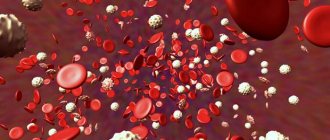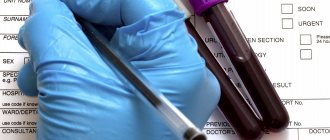Human chorionic gonadotropin (hCG) is a hormone that is normally produced only during pregnancy. It begins to be synthesized by the fertilized egg, and after the formation of the trophoblast (precursor of the placenta) - by its tissues.
Therefore, normally the hormone is not detected outside of pregnancy. When talking about hCG, we usually mean its B-subunit, which is unique, so it is almost impossible to confuse it with other hormones.
Determining the level of hCG is an important step in the diagnosis of many pathologies of the fetus and mother. In the conditions discussed below, hormone levels are usually sharply reduced or sharply reduced. In cases where deviations from the standards are small, this analysis has no diagnostic value, therefore
- chronic fetoplacental insufficiency
- post-term pregnancy
- intrauterine infection of the fetus
determined using other methods and analyses.
What is hCG used for?
- Prevents the disappearance of the corpus luteum of pregnancy and stimulates the synthesis of estrogen and progesterone in the first weeks
- Initiates changes in the anatomy and physiology of the pregnant woman’s body
- Prevents aggression of maternal immunity against fetal cells
- Stimulation of the fetal gonads and adrenal glands
- Participates in sexual differentiation in male fetuses (stimulates the production of testosterone by the fetal testes)
Deviation from the norm: what is dangerous and what to do?
If the hCG level is higher than normal in non-pregnant women (pregnancy must be ruled out by a doctor), this may indicate the following conditions:
- choriocarcinoma or its recurrence after treatment,
- hydatidiform mole,
- colon cancer,
- uterine tumors,
- rare tumors of the kidneys and lungs,
- recent abortion (induced or spontaneous),
- taking hCG drugs, for example, Pregnil.
All of these conditions, except the last two, require careful examination, since the consequences of these diseases can be fatal.
Reasons for increased hCG levels during pregnancy:
- multiple pregnancy,
- incorrectly determined gestational age,
- severe early toxicosis,
- diabetes,
- taking medications with gestagens (Duphaston, Utrozhestan, etc.),
- genetic abnormalities of the fetus.
Possible causes of low hCG levels during pregnancy:
- ectopic pregnancy,
- frozen pregnancy,
- incorrect deadline
- chronic fetoplacental insufficiency,
- threat of spontaneous abortion,
- post-term pregnancy,
- intrauterine fetal death.
To establish the exact reasons for the decrease or increase in hormone levels, you need to consult a gynecologist. He will prescribe additional research methods (ultrasound, Doppler, CTG, HD blood test), and refer, if necessary, to other specialists (for example, to a medical geneticist) or to a hospital. A repeat hCG test may be needed.
Determination of hCG levels during pregnancy
Human chorionic gonadotropin performs a tremendous function in the body. It is produced by a fertilized egg and allows pregnancy to develop, as it triggers all the processes necessary for this. This substance prevents regression of the corpus luteum and stimulates the synthesis of hormones (estrogen and progesterone) to maintain pregnancy.
- HCG is detected in blood plasma already 9 days after ovulation, that is, at the moment of implantation of the fertilized egg into the endometrium.
- During normal pregnancy, its concentration doubles every two days, reaching a peak of 50,000-10,000 IU/l at 8-10 weeks of pregnancy from the last menstruation (see calculator for calculating gestational age by week).
- Plasma hCG levels then begin to decline rapidly, by half by 18-20 weeks, after which they remain stable until the end of pregnancy.
HCG growth after conception
It is excreted from the body by the kidneys, therefore it is excreted in the urine and determined in it in the interval 30-60 days after the previous menstruation, reaching a peak at 60-70 days. This is the basis of all urinary tests during pregnancy.
From the first day of the delay, that is, approximately on the 30th day of menstruation, the hormone level is high enough to use test strips. In late pregnancy, a repeated peak of hCG may be recorded.
Previously, this was considered a variant of the norm, but this peak can have pathological significance when it is a reaction of the placenta to placental insufficiency in case of Rh conflict, when hyperplacentosis is observed. After delivery or uncomplicated abortion, no hCG should be detected in plasma or urine after 7 days, although it is common to wait 42 days before considering the presence of trophoblastic disease.
The hCG table by week of pregnancy will help you navigate the tests and consult a doctor in time if there is the slightest deviation:
| Gestational age | Average value, mIU/ml | Tolerance limits, mIU/ml |
| 2 weeks | 150 | 50-300 |
| 3-4 weeks | 2000 | 1500-5000 |
| 4-5 weeks | 20000 | 10000-30000 |
| 5-6 weeks | 50000 | 20000-100000 |
| 6-7 weeks | 100000 | 50000-200000 |
| 7-8 weeks | 80000 | 40000-200000 |
| 8-9 weeks | 70000 | 35000-145000 |
| 9-10 weeks | 65000 | 32500-130000 |
| 10-11 weeks | 60000 | 30000-120000 |
| 11-12 weeks | 55000 | 27500-110000 |
| 13-14 weeks | 50000 | 25000-100000 |
| 15-16 weeks | 40000 | 20000-80000 |
| 17-20 week | 30000 | 15000-60000 |
Causes of elevated hCG levels
- Multiple pregnancy
- Diabetes
- Chromosomal pathologies and fetal malformations
- Trophoblastic tumors
- Taking human chorionic gonadotropin for therapeutic purposes
Causes of low hCG levels
- Ectopic (ectopic) pregnancy
- Frozen pregnancy and threatened abortion
- Antenatal fetal death
- Some chromosomal abnormalities
Indications for analysis
Pain in the lower abdomen is one of the possible indications for the test
The most common indication for the test is the need to diagnose early pregnancy. Women can conduct such a test themselves using urine test strips available in pharmacies.
In women of childbearing age, hCG testing may also be indicated for:
- Delayed menstrual bleeding for more than 5-6 days;
- Amenorrhea (lack of menstruation);
- Severe irregularity of the menstrual cycle;
- Condition after taking emergency contraception (to confirm its effectiveness);
- Condition after abortion operations;
- Pain in the pelvic area;
- Bloody discharge or heavy bleeding from the vagina not associated with menstruation.
Urology patients may undergo testing
For men, the test is most often performed if the following symptoms are present:
- Unreasonable increases in body temperature;
- Erection disorders;
- Changes in the appearance of the testicles (testicles): reduction or enlargement, appearance of spots on them, painful swellings, change in skin color;
- Changes in body hair type.
For pregnant women, the analysis is indicated to monitor the development of the fetus; most often, the analysis is prescribed in conjunction with other studies. It is most important to monitor hCG levels for pregnant women who have the following risk factors:
- Age over 35 years;
- History of miscarriages;
- Inability to get pregnant for a long time;
- Endocrine diseases (diabetes mellitus type 1 or 2, hypothyroidism);
- Severe toxicosis in the early stages.
HCG as a marker of fetal abnormalities
To monitor the development of the baby, every pregnant woman should undergo prenatal screening (see first trimester screening). It consists of several stages, including assessment of ultrasound data and hormone levels, including hCG.
In the first trimester, at 10-14 weeks, 2 biochemical markers are examined:
- hCG
- PAPP-A (pregnancy-associated plasma protein A)
In the second trimester, at 16-18 weeks, a woman undergoes a triple test:
- AFP (alphafetoprotein)
- hCG
- estriol-A
Data from these screenings, together with ultrasound results, make it possible to assess the risks of having a child with certain chromosomal abnormalities and developmental defects. These risks are calculated taking into account the mother’s age, her weight and the health of children from previous pregnancies.
In the 90s of the 20th century, scientists noted that in the blood of mothers carrying children with Down syndrome, the level of hCG was increased twofold or more. The mechanism for increasing the hormone is still not exactly clear, but human chorionic gonadotropin is the most sensitive marker for trisomy 21 chromosomes.
HCG norms
It is human chorionic gonadotropin that controls the production of progesterone and estrogen, and if this hormone is not enough, spontaneous miscarriage can occur. During pregnancy, the hCG value will gradually increase, reaching a maximum concentration by 11 weeks, after which the level of this hormone gradually decreases until delivery.
Gonadotropin is present in small quantities as a subunit in all people. Its normal value reaches less than 5 units in men and non-pregnant women. If the study showed that the hormone began to increase, then this may indicate the development of some pathology such as testicular tumors in men and ectopic pregnancy or amenorrhea in female patients.
HCG for ectopic pregnancy
An ectopic pregnancy is a condition in which a fertilized egg implants anywhere other than the inner layer of the uterus (endometrium). More often it is located in the fallopian tubes, less often in the uterus, ovaries, and even on the intestines. The danger of an ectopic pregnancy is that it is sure to be interrupted (with the exception of a few cases). As a result, a woman may die from profuse internal bleeding, which is very difficult to stop. But there is a “gold standard” of diagnosis, which allows you to make such a diagnosis and take timely measures. This is an ultrasound examination combined with the determination of hCG in a woman’s blood.
During ectopic pregnancy, the conditions for egg attachment are extremely difficult, so the trophoblast secretes significantly less human chorionic gonadotropin than during normal pregnancy. If the hormone level grows extremely slowly and does not correspond to the norms for the weeks of pregnancy, then it is necessary to perform an ultrasound with a vaginal sensor to find the fertilized egg in or outside the uterus. This is possible with a high probability at a hCG level of 1000 IU/l. If the embryo is not found with such an amount of hormone, then laparoscopic surgery and search for the fertilized egg are necessary.
Signs of an ectopic pregnancy
- abdominal pain after missed period
- pain during vaginal examination and intercourse
- sometimes – bloody vaginal discharge
- fainting with delayed menstruation
If the above-described signs appear, you must consult a doctor, do an ultrasound and take a hCG test (often dynamically) to rule out ectopic pregnancy.
HCG test during pregnancy - meaning
Firstly, an analysis of the level of hCG in the blood can confirm that you will become a mother already 5-6 days after conception. This is much earlier and, most importantly, much more reliable than using conventional rapid tests.
Secondly, the test is necessary to determine the exact duration of pregnancy. Very often, the expectant mother cannot name the exact date of conception or gives it, but incorrectly. At the same time, each period corresponds to certain indicators of growth and development; deviations from the norm may indicate the occurrence of complications.
Thirdly, the level of hCG in the blood can quite accurately “tell” whether your baby is developing correctly.
An unscheduled increase in hCG levels usually occurs with multiple pregnancy, gestosis, taking synthetic gestagens, diabetes mellitus in the expectant mother, and can also indicate some hereditary diseases in the baby (for example, Down syndrome) and multiple developmental defects. An abnormally low level of hCG can be a sign of an ectopic and non-developing pregnancy, delayed fetal development, threatened spontaneous abortion, and chronic placental insufficiency.
However, do not rush to sound the alarm: increased or decreased values may also indicate that the gestational age was initially set incorrectly. Your doctor will help you interpret test results correctly.
Frozen pregnancy and antenatal fetal death
Sometimes it happens that after a delay in menstruation and a positive pregnancy test, signs of pregnancy do not occur or end abruptly. In these cases, the embryo dies, but for some reason the miscarriage does not occur. As a result, the level of human chorionic hormone, which corresponded to the gestational age, stops growing and then decreases. On an ultrasound, you can see an embryo without a heartbeat or even an empty fertilized egg (anembryony). This condition is called a frozen (non-developing) pregnancy.
Causes of frozen pregnancy
- chromosomal abnormalities (most pregnancies that fail to develop before 10 weeks)
- maternal infections (often chronic endometritis)
- anatomical defects of the uterus
- maternal blood clotting disorder (thrombophilia)
If, after a detected frozen pregnancy, a miscarriage does not occur in the near future, then it is necessary to perform a medical abortion or curettage of the uterine cavity. If pregnancy loss occurs 2 or more times, the couple needs to be examined to determine the causes of this condition.
If the fetus dies at a later stage, it is called antenatal death. Since during long periods the hCG level is not measured over the weeks of pregnancy, it has no diagnostic value, although a decrease in the hormone occurs in any case.
What is hCG?
HCG or human chorionic gonadotropin is a pregnancy hormone. “Chorionic” means that the hormone is synthesized by the chorion, which is the membrane of the fertilized egg. Subsequently, the placenta is formed from the chorion cells. “Gonadotropin” means that the hormone acts on a woman’s sex glands (gonads), helping to maintain pregnancy. HCG suppresses the production of estrogen by the ovaries, reduces the protective functions of the immune system, which prevents rejection of the fertilized egg and maintains the normal course of the gestation period.
HCG is a glycoprotein. It consists of 2 subunits. The alpha unit has the same structure as other glycoproteins (TSH, FSH, luteotropic hormone) and has no diagnostic value. To detect pregnancy and assess fetal development, the concentration of the beta unit, which has a unique structure, is important. Diagnosis of total hCG (alpha and beta units) is less informative than the assessment of beta hCG. Currently, the assessment of the beta unit of the hormone is used to determine pregnancy.
In non-pregnant women and men, the hormone corresponds to a level of 5 mIU/ml (milliinternational units in 1 milliliter). A questionable result is in the range of 6-24 mIU/ml and requires monitoring the hCG level over time after 2-3 days. An indicator that corresponds to 25 mIU/l and above indicates pregnancy.
Trophoblastic tumors
Another pregnancy pathology diagnosed by assessing hCG levels is trophoblastic tumors.
Complete and partial hydatidiform mole
During the development of a normal pregnancy, the sperm, merging with the egg, forms a zygote, which equally combines maternal and paternal genetic information. But sometimes there is a loss of the “female contribution” when the chromosomes of the egg are, as it were, expelled from the fertilized egg. In this case, a condition similar to pregnancy develops, but only based on the paternal genetic material. This phenomenon is called a complete hydatidiform mole. With a partial hydatidiform mole, the information from the egg remains, but the information from the sperm is doubled.
Both in normal pregnancy and in hydatidiform pregnancy, the paternal chromosomes are responsible for the trophoblast and the formation of the placenta. In the case of doubling of these chromosomes, the trophoblast begins to develop at tremendous speed, releasing large quantities of hormones, including hCG, into the blood. This is what the diagnosis of this disease is based on.
With a hydatidiform mole, the development of a normal pregnancy is impossible; it ends in spontaneous abortion. But the biggest problem is that the hyperactive trophoblast begins to invade the uterus, then beyond it, sometimes turning into a malignant tumor with metastases. Therefore, it is important to detect this disease in time and begin treatment.
Signs of hydatidiform mole:
- uterine bleeding in early pregnancy
- uncontrollable vomiting (more painful than during normal pregnancy)
- the size of the uterus is larger than it would be at this age
- sometimes – symptoms of preeclampsia
- rarely - rapid heartbeat, trembling fingers, weight loss
With such signs, it is necessary to consult a doctor, perform an ultrasound and measure the level of hCG in the blood. During normal pregnancy, the level of this hormone rarely exceeds 500,000 IU/l, and there are approximate norms for each stage of pregnancy. With hydatidiform mole, the amount of hCG exceeds them several times.
Treatment for hydatidiform mole involves removing all trophoblast from the uterus. This can be done by curettage or other surgical intervention. Sometimes a relatively benign hydatidiform mole turns into a frankly malignant chorionic carcinoma. This tumor metastasizes very quickly, although it responds well to chemotherapy.
Indications for chemotherapy for hydatidiform mole:
- the amount of hCG exceeds 20,000 IU/l a month after removal of the hydatidiform mole
- increase in hCG levels after removal of a hydatidiform mole
- metastases to the liver, stomach, brain
Chorionic carcinoma
Chorionic carcinoma can occur not only after a hydatidiform mole, but also after a successful birth or abortion. In this case, 40 days after the end of pregnancy, the hCG level does not fall, but often rises. A woman may be concerned about uterine bleeding and signs of metastases to organs. In such cases, treatment is carried out with chemotherapy (methotrexate and other drugs), surgery and further observation.
Norms
Normally, a blood test for hCG will show a negative result, but the level of hCG in pregnant women is constantly changing, and it is this dynamics that matters. At each stage of gestation, the normal level of hCG has a different value.
At the same time, the standards for each laboratory may differ slightly, so you need to choose one clinic and undergo the study there throughout the entire 9 months of gestation.
Below are the average values.
First trimester
In the first trimester of pregnancy, human gonadotropin grows as quickly as possible; depending on the period, the results of the analysis can vary thousands of times.
| Length of pregnancy | Minimum value | Maximum value |
| No pregnancy | 0 | 5,3 |
| 3-4 weeks | 16 | 156 |
| 4-5 weeks | 101 | 4870 |
| 5-6 weeks | 1110 | 31500 |
| 6-7 weeks | 2560 | 82300 |
| 7-8 weeks | 23100 | 151000 |
| 8-9 weeks | 27300 | 233000 |
| 9-13 weeks | 20900 | 291000 |
Second trimester
By the second trimester, the growth of hormone levels stops and declines.
| Length of pregnancy | Minimum value | Maximum value |
| 13-18 weeks | 6140 | 103000 |
| 18-23 weeks | 4720 | 80100 |
| 23-27 weeks | 2700 | 78100 |
Third trimester
Starting from about 21-23 weeks, the normal blood level does not change and its values can vary from 2700 to 78100.
Taking medications containing human chorionic gonadotropin
The results of a blood test for hCG, including during screenings, can be affected by taking this hormone orally. It is usually prescribed for infertility and as a preparation stage for IVF.
It is very rarely taken for threatened abortion at short term. In any case, if you are taking this drug or any other hormonal medications, be sure to notify your doctor.
When can a false positive test result occur?
- As some sources indicate, taking COCs (oral contraceptives) can affect the analysis. This is not correct information. Taking contraceptives does not affect hCG levels. The result of the analysis is influenced by the intake of the drug human chorionic gonadotropin, usually as a stage of the IVF protocol.
- After childbirth or abortion, hCG usually drops to normal within 7 days. Sometimes they wait up to 42 days before making a diagnosis. If it does not fall, or even begins to grow, then it may be a trophoblastic tumor.
- Other tumors may produce an increase in the hormone in metastases of hydatidiform mole or chorionic carcinoma.
- There are other tumors from germinal tissues, but they rarely give rise to hCG. Therefore, if there is a formation in the lungs, stomach or brain plus high hCG, then first of all they think about trophoblastic tumors with metastases.
Blood test for hCG: how to take it correctly and when to take it
The material for analysis is venous blood. The study is carried out using the enzyme immunoassay method. To ensure maximum sensitivity and specificity of the test, the test is taken in the morning on an empty stomach. 8-10 hours before donating blood, do not eat, and also avoid heavy physical activity. If you are taking medications that affect hormonal activity, you should inform the laboratory employee about this.
Before donating blood for hCG, you should avoid physical activity.
Many patients, not knowing when to take a blood test for pregnancy (hCG), do the test too early. The test will show a positive result only a week after conception. The most favorable time for diagnosing pregnancy is 4–5 days of delayed menstrual bleeding. Often at this stage, hCG appears in the urine.
When the concentration of hCG in a woman’s blood is 5–25 mU/l, pregnancy cannot be definitively confirmed or excluded. In this case, a repeat study is carried out after 2-3 days.
In the second trimester, the level of human chorionic gonadotropin is determined to diagnose fetal pathologies. After a miscarriage or medical abortion, it is recommended to take an hCG blood test after 48–72 hours. A high level of this hormone indicates incomplete removal of the fertilized egg from the uterine cavity.
How long does the analysis take? The turnaround time for receiving analysis results is usually about 2–3 days, which depends on the equipment of a particular laboratory. To avoid waiting for a long time, you can do a rapid test. This method allows you to get results within 2-3 hours.
Immunity against hCG
In rare cases, a woman’s body develops immunity against human chorionic hormone. The resulting antibodies to this substance prevent the fertilized egg from attaching normally in the uterus and developing. Therefore, if a woman’s 2 or more pregnancies ended in early spontaneous abortion, then it is worth getting tested for antibodies to hCG.
If the results are positive, treatment is prescribed during the 1st trimester. It consists of glucocorticoids and low molecular weight heparins. We must not forget that this pathology is very rare, so before treatment it is necessary to exclude other causes of infertility and miscarriage.
Determining the level of human chorionic hormone is an important step in monitoring the health of a woman and baby. But this analysis should be prescribed by a doctor, since hCG norms for weeks of pregnancy have an average value, and incorrect interpretation of the indicator leads to causeless anxiety and worry, which is extremely undesirable during pregnancy.
How to get tested?
For screening diagnostics of intrauterine development disorders, from the 8th week of pregnancy it is advisable to conduct a regular test - a general blood test for hCG. When preparing for it, it is useful to understand and remember how to take an hCG test. This test does not require special preparatory measures; the doctor prescribing this test usually warns that blood for the study will be taken from a vein in the morning on an empty stomach.
If a study is necessary to confirm the fact of conception, it is carried out no earlier than 3-5 days after the delay in regulation.
FAQ
Hello! The pregnancy test shows 2 lines, my period is already about 3 weeks late. But the ultrasound still hasn’t found a fertilized egg. Blood test for hCG: 7550 mIU/ml. How long can I wait for embryo imaging?
With modern devices, the fertilized egg is visible in the uterus or outside it already at a hormone concentration of more than 1000 mIU/ml. Therefore, in your situation, you need to immediately consult a doctor to find a solution. You may have to undergo laparoscopic surgery. Delaying a visit to the doctor can result in internal bleeding after termination of an ectopic pregnancy.
At screening at 13 weeks of pregnancy, risks were calculated; for almost all pathologies they turned out to be high. After chorionic villus biopsy, a fetal karyotype of 69xxx was obtained. They offer an interruption. Is hydatidiform mole possible in my case?
Triploidy may indicate the formation of a partial hydatidiform mole. Since a fetus with such a set of chromosomes is not viable, you are recommended to terminate the pregnancy, followed by ultrasound and monitoring of the b-subunit of hCG. The material obtained after the interruption must be sent for histological examination.
After completing the screening, I was given the results in the form of hCG and PAPP-A values. The value of human chorionic gonadotropin is slightly higher than normal. How dangerous is this?
The results of any screening should be given in the form of a quantitative value of individual risks. For example,
- risk of Edwards syndrome: 1:1400
- risk of Down syndrome: 1:1600
- risk of Patau Syndrome: 1:1600
- risk of neural tube defect 1:1620
In the form in which the results were given to you, it is impossible to determine the risks. Contact the laboratory where you took the tests and ask them to calculate your individual risks.
Author:
Evtushenko Anna Aleksandrovna obstetrician-gynecologist
Diagnosis of ectopic pregnancy using hCG
Sometimes the fertilized egg, for some reason, becomes attached outside the uterine cavity. Such a pregnancy is called an ectopic pregnancy and cannot lead to the birth of a child. But at the same time, such a pregnancy poses a threat to a woman’s life. Delayed detection of an abnormal pregnancy can lead to rupture of tissues and large vessels. Enlargement of the embryo outside the uterine cavity leads to rupture of the internal organs of the reproductive system and causes bleeding, which is often very difficult to stop. If a woman is not taken to the hospital in a timely manner to provide the necessary medical intervention, the patient may die. Before such serious consequences occur during an ectopic pregnancy, a woman often experiences the same symptoms and sensations as during a normal pregnancy. During an ectopic pregnancy, the level of gonadotropin does not reach the lower limit of the norm established for its term. This allows the doctor to detect the pathology in time and provide the woman with the required assistance before serious complications arise.
The level of hCG during an ectopic pregnancy will be significantly lower than the established standards, and this will allow a timely response to the situation that has arisen.
However, if you pay close attention to your condition, you can suspect something is wrong based on the following symptoms:
- dizziness;
- unclear positive pregnancy test (dim indicator on a pharmacy test);
- the appearance of bloody discharge;
- the occurrence of pain in the lower abdominal cavity;
- fainting.
How to recognize an ectopic pregnancy?
To identify and confirm such a serious anomaly as an ectopic pregnancy, obstetricians analyze data from all available diagnostic methods in combination, namely:
- medical examination. A specialist, through a routine examination, may suspect a pathology and prescribe additional tests;
- ultrasonography. Using an ultrasonic sensor, medical specialists identify the exact location of attachment of the fertilized egg in the woman’s pelvic organs;
- A blood test for hCG indicators is highly informative for the attending physician in terms of identifying pathological gestation.
Why determine hCG during ectopic pregnancy?
A timely detected pathological pregnancy allows the doctor to determine all the nuances of the situation in which the woman finds herself and make the right decision on treatment and preservation of her reproductive health.
Often, such a pathological pregnancy until a certain period proceeds in exactly the same way as a uterine one. The deterioration of a woman’s well-being occurs suddenly and the patient and doctor have very little time to take action.
Therefore, for the early detection of such a dangerous pathology, a special blood test is used, which reveals the value of hCG during pregnancy in the early stages, indicating improper attachment of the fertilized egg. If low levels are detected, doctors conduct an examination and ultrasound examination of the patient. If the diagnosis is confirmed, then measures are taken to remove the fertilized egg. Detection of an ectopic pregnancy, together with timely measures taken, minimizes the negative consequences for the woman. After rehabilitation therapy, she still has a high chance of bearing and giving birth to a healthy child.
How to understand the analysis
You can notice changes in the level of beta-hCG in the blood only on the sixth day of pregnancy. Since not every woman can say exactly when conception occurred, doctors recommend taking a test five days after the delay. All results obtained previously, both increased and decreased, are considered unreliable.
The fact is that during pregnancy, interpretation of the results may show its absence if the amount of the hormone is still so small that it is not determined during the study. If there is no pregnancy, high levels of the hormone may be due to the development of pathological processes in the body (diabetes mellitus, benign or malignant tumors).
Since beta-hCG very accurately reflects the health status of a pregnant woman, the doctor prescribes a test in the following situations:
- for diagnosing pregnancy;
- monitoring the progress of pregnancy in order to promptly detect pathologies in the development of the fetus, frozen pregnancy, or death of the child;
- to make sure there is no ectopic or false pregnancy;
- assess the risk of miscarriage;
- absence of menstruation;
- monitor the patient’s condition after an abortion;
- suspicion of a malignant or benign tumor, monitoring cancer treatment.
The amount of hCG in the blood doubles every two days during the first six weeks. Then its growth slows down and doubles every three days. After two months, the amount of hCG still increases, but not so quickly, and at the beginning of the second trimester, when the need for the corpus luteum disappears, the level of the hormone begins to subside, but remains high until the end of pregnancy.
What should be the norm of the hCG hormone during pregnancy can be seen in the following table (the data is given in weeks, but there are also more detailed tables where the numbers are given by day):
| Time from conception (in weeks) | Amount of hCG (mU/ml) |
| 1-2 weeks | 25 — 156 |
| 2-3 weeks | 101 — 4 870 |
| 3-4 weeks | 1 110 — 31 500 |
| 4-5 weeks | 2 560 — 82300 |
| 5-6 weeks | 23 100 — 15 100 |
| 6-7 weeks | 27 300 — 233 000 |
| 7-11 weeks | 20 900 — 291 000 |
| 11-16 weeks | 6140 — 103 000 |
| 16-21 weeks | 4 720 — 80 100 |
| 21-39 weeks | 2 700 — 78 100 |
Having studied the table, it is obvious that if blood is donated after a delay, and the transcript of the analysis shows 111 mU/ml, this indicates the second week of pregnancy. If the result is below 25, but above 15, this means that in a few days you will need to donate blood again, since this result can neither refute nor confirm pregnancy. If the numbers are extremely low, for example, 0.08, this means that pregnancy has not occurred.
If a pregnant woman’s results are increased or decreased, there is no need to panic right away, as this may indicate that the due date has been set incorrectly. Therefore, you should not decipher your results yourself, but you need to wait for the doctor’s verdict, for which you will have to undergo additional examinations.
HCG indicators
This table shows the approximate normal values of human chorionic gonadotropin.
| Gestation period (by weeks) | Average (mIU/ml) | Reference (mIU/ml) |
| 2 | 170-200 | 100-350 |
| 3-4 | 3500 | 2500-5500 |
| 4-5 | 25000 | 15000-35000 |
| 5-6 | 60000 | 25000-105000 |
| 6-7 | 125000 | 55000-210000 |
| 7-8 | 125000 | 45000-210000 |
| 8-9 | 95000 | 35000-150000 |
| 9-10 | 85000 | 37000-135000 |
| 10-11 | 82000 | 37000-128000 |
| 11-12 | 76000 | 33000-119000 |
| 13-14 | 68000 | 31000-106000 |
| 15-16 | 55000 | 25000-85000 |
| 17-20 | 45000 | 25000-65000 |
When comparing the results of the table with the laboratory data obtained, it should be remembered that in the first weeks the concentration of the hormone can be very variable (from 30 to 5000 mIU/l), which is associated with its accelerated production.
Norm of human chorionic gonadotropin by day in the early stages: table
Below we will consider the hCG table by day from the moment of conception. Here you will find the minimum, average and maximum gonadotropin levels from the first to 41 days after fertilization.
| Day after conception | Minimum | Average quantity | Maximum |
| 7 | 3 | 6 | 13 |
| 8 | 5 | 9 | 22 |
| 9 | 6 | 19 | 28 |
| 10 | 10 | 20 | 29 |
| 11 | 12 | 26 | 49 |
| 12 | 17 | 45 | 70 |
| 13 | 24 | 79 | 168 |
| 14 | 29 | 110 | 189 |
| 15 | 39 | 168 | 279 |
| 16 | 68 | 268 | 489 |
| 17 | 123 | 420 | 546 |
| 18 | 231 | 668 | 858 |
| 19 | 372 | 989 | 1478 |
| 20 | 531 | 1388 | 2021 |
| 21 | 786 | 1964 | 3234 |
| 22 | 1068 | 2697 | 4978 |
| 23 | 1429 | 3569 | 6223 |
| 24 | 1844 | 4664 | 7989 |
| 25 | 2446 | 6153 | 9878 |
| 26 | 4257 | 8176 | 15656 |
| 27 | 5433 | 10259 | 19589 |
| 28 | 7207 | 11445 | 28434 |
| 29 | 8888 | 13789 | 34078 |
| 30 | 10622 | 16789 | 40523 |
| 31 | 11623 | 19735 | 61099 |
| 32 | 12956 | 23689 | 64056 |
| 33 | 15078 | 25089 | 69070 |
| 34 | 15678 | 28134 | 70540 |
| 35 | 18043 | 32089 | 75038 |
| 36 | 20046 | 37089 | 79049 |
| 37 | 21779 | 39923 | 84089 |
| 38 | 23035 | 46567 | 88527 |
| 39 | 25079 | 58076 | 108080 |
| 40 | 26545 | 63534 | 116036 |
| 41 | 28012 | 65089 | 125029 |
The table shows that approximately on day 40, chorionic gonadotropic levels reach their maximum. Later, hCG begins to subside, which is considered a normal physiological state.
Causes of high human chorionic gonadotropin levels
Pregnant women may experience not only a low level of the hormone in question, but also its high levels, which often also indicates various abnormalities. A blood test helps determine the amount of hCG. It can be taken in both public and private clinics. So, what disorders are indicated by a high level of human chorionic gonadotropin in a woman while carrying a baby:
- Oncological neoplasms in women in the genitourinary system.
- Choriocarcinoma is a tumor of the trophoblastic type, resulting from the transformation of the chorionic epithelium into a malignant formation.
- Hydatidiform mole is a condition in which a fluid-filled cavity forms in place of the embryo.
- Chromosomal abnormalities - Down syndrome, severe pathologies of the fetal brain and heart.
- High levels of the hormone often occur with twins or triplets, that is, if several embryos develop in the womb at once. This is a completely normal physiological state.
Another reason is severe pathologies of the endocrine system of the mother and fetus.
If a high level of hCG is detected in the patient’s blood, the expectant mother is required to undergo additional medical examination and assessment of the gonadotropin level over time.
Causes of low levels of human chorionic gonadotropin
HCG levels below normal may indicate various disorders in fetal development. Let's look at a few common reasons:
- A low level of the hormone is observed during a frozen pregnancy, when the fetus for some reason stops its development.
- Error in calculation between embryonic and obstetric periods.
- Insufficient concentration of the substance in question is observed during ectopic pregnancy. This is a condition when a fertilized egg is implanted not in the uterus itself, but, for example, in the ovary or on the cervix.
- Often, low levels of the hormone occur during IVF after embryo transfer.
- The deviation is also diagnosed when the fetus freezes or the child has various developmental anomalies.
- Low hCG is diagnosed when there is a threat of miscarriage.
You might be interested in: Pregnancy 44 weeks
In the third trimester, a high percentage of this substance is observed during prolonged pregnancy, which requires urgent stimulation of labor.
To confirm or refute various abnormalities in the fetus with low hCG levels, the pregnant woman is prescribed an ultrasound examination and additional tests.
About hCG in general
A pregnancy test cannot always determine its presence, especially in the very early stages. To determine pregnancy, a blood test is the most reliable source of necessary information. This is explained by the fact that during the period of conception, a change in the hormonal balance occurs in the female body. Initially, this is the appearance of a membrane around the cell, which begins to produce the hCG hormone.
There are cases when a general test does not show the presence of pregnancy, but a blood test makes it possible to reliably determine the level of the hCG hormone and thereby determine the likelihood of conception already 5 days after fertilization of the egg. In addition, the beta-hCG hormone is an indicator for determining the presence of abnormal fetal development, identifying the threat of miscarriage and establishing the exact duration of pregnancy.
Error in deadlines
The gynecologist’s task when a patient comes to him is to correctly calculate the duration of pregnancy. This period is usually calculated from the first day of the last menstruation or the day of ovulation in case of a regular cycle for the expectant mother.
Sometimes it may be that the doctor incorrectly calculates the timing. This can happen, for example, if ovulation is late or if a woman does not remember the date of her last menstrual period. Actually, if the period is calculated incorrectly, the HCH will deviate from the norm. To confirm the timing of pregnancy, an ultrasound examination must be performed.
TSH norms during pregnancy, reasons for a decrease or increase in the hormone
TSH or thyrotropin, thyroid-stimulating hormone is a product of the anterior pituitary gland that regulates thyroid function. The latter contains its receptors, with the help of which high thyrotropin stimulates the thyroid gland to produce and activate its hormones.
The essence of the problem
The thyroid gland completely determines all types of metabolism in the body, the work of the cardiovascular system, gastrointestinal tract, central nervous system, and reproduction. Thyrotropin and thyroid hormones have a feedback relationship (swing). From the moment of pregnancy, a woman’s whole body changes, and the endocrine glands are no exception. Hormonal levels begin to fluctuate, which is normal.
Based on TSH levels, the doctor has the whole picture of the course of gestation. When registered with the LCD, the gynecologist will refer the woman for TSH during pregnancy, and if there have already been problems with the thyroid gland in previous births, the test must be taken even when planning pregnancy and kept under control during the first 10 weeks of pregnancy.
Such women must undergo a full examination before becoming pregnant. The fact is that when pregnancy occurs, it is the thyroid-stimulating hormone that reflects the condition of the thyroid gland. TSH is disturbed in pathologies of the liver and kidneys, mental disorders, and constant lack of sleep.
How does thyroid-stimulating hormone behave during pregnancy?
During gestation, the fetus does not yet have a thyroid gland until the 10th week and does not need the TSH hormone; Mom’s iron therefore works for two. There is a special table of immunological studies for the thyroid group, which is available to any endocrinologist. The upper norm of the TSH hormone fluctuates around 2-2.5 µIU/l. Moreover, this should happen both during planning and when conception occurs.
The lower limit of TSH should be at least 0.5 µIU/l - this is normal. Numbers below this are already pathological. There is no need to determine TSH by week; it is enough to determine it by trimester.
Standards:
- 1st trimester - 0.1-0.4 mU/l or mIU/l;
- 2nd trimester - 0.3-2.8 mU/l;
- 3rd trimester - 0.4-3.5 mU/l.
TSH during pregnancy is normal: during pregnancy it ranges from 0.2 to 3.5 mIU/l. These standards vary from country to country.
In the CIS, TSH norms during pregnancy by trimester are as follows: the accepted indicator is 0.4-2.5 mIU/l in the 1st trimester and 0.4-4.0 mIU/l in the 2nd and 3rd trimesters. Some experts indicate that the maximum value may be 3 mIU/l. In other regions, the norms for pregnant women are different. For example, in America they are lower.
Symptomatic manifestations of thyrotropin deficiency
Below normal - this means close to 0. T4 increases. Symptoms:
- tachycardia appears with increased cardiac output;
- AH above 160 mmHg;
- severe cephalgia;
- the temperature becomes constantly low-grade;
- Appetite increases and a feeling of constant hunger appears against the background of decreased weight.
A pregnant woman's emotional background changes: the woman becomes irritable, unbalanced, and may experience convulsions and tremors of the limbs.
Reasons for decreased thyrotropin
Low TSH during pregnancy can occur:
- during fasting and strict diets;
- stress;
- Sheehan syndrome (atrophy of pituitary cells after childbirth);
- self-medication for hyperthyroidism;
- insufficient functioning of the pituitary gland;
- formations and nodes of the thyroid gland, affecting the production of hormones;
- with iodine deficiency.
If the condition does not respond to conservative therapy with thyreostatics, they even resort to resection of the thyroid gland in women during pregnancy.
Thyrotropin and conception
The work of the thyroid gland should dominate when planning pregnancy. Its failure may prevent you from conceiving and bearing a fetus. The influence of TSH in a girl on conception is such that when a doctor sees anovulation on an ultrasound of the pelvic organs, and the luteal body is underdeveloped, he will always refer you for a TSH test.
In general, elevated TSH can negatively affect the ovaries - it inhibits the development of the corpus luteum. If the indicated elevated TSH does not have time to act on ovulation, conception occurs.
How does TSH affect conception? In general, TSH itself has little effect on fertilization; conception is affected by diseases that cause infertility. These include manifest hypothyroidism (TSH should be high and T4 should be low); the state of hyperprolactinemia is an increased amount of prolactin. If TSH is elevated during pregnancy, but thyroid hormones remain in the N, the pregnancy proceeds normally.
Behavior of TSH during pregnancy
1st trimester - when a zygote appears in the body, hCG is produced - human chorionic gonadotropin. It stimulates the work of the thyroid gland, under its influence it works stronger than its normal norm and increases by 50%. A lot of thyroxine accumulates in the blood. Her hormones jump sharply and TSH drops in the first trimester of pregnancy.
From the 10th week, hCG begins to gradually decrease and by the beginning of the 2nd trimester it drops significantly. This leads to an increase in TSH and free T4, but within normal limits. Estrogens begin to rise, free hormones become less and less.
From the beginning of the 2nd trimester until childbirth, elevated TSH during pregnancy in the presence of associated hormones increases, but not more than normal. Therefore, this is not considered a pathology.
If at the end of the 1st trimester the TSH value is low and has not increased, this is already a sign of thyrotoxicosis. A decrease can lead to placental abruption. Even when childbirth occurs, defects and anomalies may later be discovered.
First trimester
Thyroid-stimulating hormone in the early stages of pregnancy: in a healthy potential mother, it is always low in the first 12 weeks of pregnancy. Ideally, the TSH norm is no higher than 2.4-2.5 µIU/ml - the numbers should be average: 1.5 - 1.8 µIU/ml.
TSH does not pass through the placenta, but its thyroid hormones do. With the indicated numbers, TSH-T4 free during pregnancy will be exactly in the range that will allow the fetus to develop normally.
In case of multiple pregnancy, TSH is below normal, close to 0. Week 10-12 – has the lowest TSH. It is suppressed by hCG. Then it can increase.
2nd and 3rd trimester
Normal TSH in the second trimester of pregnancy: during pregnancy, the 2nd trimester already has a normal gradual increase in thyrotropin. From the 18th week of pregnancy, the fetus already has its own working thyroid gland, and in the second trimester it begins to produce TSH from the 15th week of gestation. Now the function of protecting the fetus from intoxication by maternal hormones is triggered: the corpus luteum is completely reduced and only the placenta functions.
Second trimester of pregnancy: estrogens increase, they increase the synthesis of transporter proteins that bind free T3 and T4 and reduce their quantity. Thyroid-stimulating hormone (TSH) in the 3rd trimester in pregnant women approaches the usual thyroid level, since a decrease in hCG also helps to transfer the thyroid gland to a normal rhythm. All this leads to an increase now already in the third trimester of pregnancy.
Only such a decoction will trigger REGENERATION of the thyroid gland
The goiter will disappear in 3 days! This remedy has become a sensation in the treatment of the thyroid gland!
The values will fluctuate, but within normal limits. An endocrinologist controls this process.
High levels of TSH during pregnancy can lead to hypothyroidism and complications: miscarriages, abruption, fetal deformities.
The effect of TSH on the fetus and pregnancy is such that the development of congenital hypothyroidism and cretinism is possible. But this is in theory, not guaranteed. This will only manifest itself when thyroid-stimulating hormone levels are too high.
TSH should be more than 7. Then treatment is required. The most common causes of increased TSH:
- this is a pituitary adenoma;
- adrenal dysfunction;
- gestosis;
- severe somatics;
- cholecystectomy;
- taking antipsychotics;
- iodine deficiency;
- excess doses of iodine preparations; kidney pathologies;
- hemodialysis;
- hypothyroidism;
- lead poisoning.
Treatment becomes necessary if the TSH level in pregnant women is above 7 units - Eutirox or L-thyroxine is prescribed.
Symptoms of high TSH
If TSH levels are 2.5 times or more above normal, this is especially dangerous in the first 12 weeks.
Manifestations and symptoms:
- slowness of reactions;
- lethargy;
- absent-mindedness;
- irritability;
- neck deformities;
- decreased appetite up to its complete absence;
- symptoms of constant nausea combined with steady weight gain;
- constant constipation;
- temperature is below normal;
- There are also symptoms of skin changes: it is dry and pale;
- hair fall out;
- brittle nails;
- tendency to swelling on the body and face;
- the appearance of fatigue and weakness in the morning;
- daytime sleepiness and insomnia at night.
Many signs may resemble early toxicosis, so it is better to find out the causes of the condition from a doctor. But more often the symptoms do not attract attention, because in the CIS the Chernobyl accident still resonates and chronic iodine deficiency is noted.
A high TSH level should not cause panic, because it is easy to correct conservatively. But high TSH indicates the onset of goiter or thyroiditis. The decision about tests is made by the doctor. If a thyroidectomy was performed before conception, hormones are taken throughout pregnancy.
What conditions can thyroid gland have?
- Eutheriosis – the functioning of the gland is normal.
- Thyrotoxicosis – not only a decrease in TSH is noted, but also an excess of thyroid hormones and poisoning by them. This is Graves' disease.
- Hyperthyroidism is an excess of hormones without intoxication.
- Hypothyroidism is a lack of T3 and T4 during pregnancy.
Taking tests
It must be carried out with certain preparation. To identify the functioning of the thyroid gland, blood test for TSH in women: TSH during pregnancy is determined for several days in a row, at the same time.
Avoid alcohol and smoking for 2-3 days. During pregnancy, how to take the test correctly: it is taken at 6-8 weeks of pregnancy. Avoid taking any drugs, especially hormones. Any loads are also excluded.
A TSH test (test) during pregnancy is taken on an empty stomach, in the morning, preferably before 9 o’clock. Often, your doctor may send you for testing even without symptoms.
Principles of treatment
HRT is not prescribed without a clinic. If the TSH level during pregnancy is increased only to 4 mU/l, and free T4 is normal, therapy is not needed. It is prescribed only when T4 decreases. Treatment is carried out with thyroxine. Conservative treatment corrects hormone status well.
It should be noted that during the postpartum period you should never stop taking Thyroxine on your own. But it makes sense to discuss the dosage of Thyroxine during breastfeeding if TSH has increased after childbirth.
By normalizing hormonal levels, it is possible to completely cancel treatment with Eutirox if TSH after childbirth was high before the measurement. Sometimes it is enough to correct iodides without hormones. An overdose of iodine can increase thyrotropin. Treatment should be prescribed not by a gynecologist, but by an endocrinologist.
The course, dosage and treatment regimen are always individual. You cannot self-medicate. TSH levels during pregnancy can be maintained with proper nutrition: increase proteins, reduce fats and simple carbohydrates, salt. This is always useful. More red vegetables, greens, apples, persimmons, cereals, seaweed, i.e. such a diet to reduce iodine deficiency. You also need good sleep, fresh air and moderate physical activity.
Decoding the results
Normally, in a woman carrying a baby, the considered indicators rapidly increase at approximately 6-12 weeks, and then begin to rapidly fall. If a woman suspects that pregnancy has occurred, but the test shows a negative result, the test should be repeated a week later. By this time, the amount of hCG should reach at least 25 mIU/ml. It is worth noting that during a multiple pregnancy, human chorionic gonadotropin will be exponentially higher, because each embryo synthesizes a certain amount of this substance.
If the patient exhibits deviations from the norm by more than 20%, she is indicated for additional medical examination to identify the causes of this condition. Interpretation of the results should be done exclusively by a specialist, taking into account data obtained as a result of other types of examination of the expectant mother.
Change in indicator
As can be seen from the table, in the first half of pregnancy the level of the hormone increases and then gradually decreases. Already a week after birth it becomes 1-5 mU/ml again.
Each woman’s body is unique, so the numbers may differ slightly from conventional norms. It is advisable to draw conclusions about normality or pathology by considering the hCG level over time.
Throughout pregnancy, a woman undergoes scheduled tests to determine hCG levels. The result is deciphered, no longer relying on generally accepted norms, but on the previous results of a particular woman in labor. If the changes do not correspond to the week of pregnancy, a repeat analysis or other diagnostic methods (general, biochemical blood test, ultrasound) may be required.
Why are changes in human chorionic gonadotropin levels so important? The fact is that hCG in the first weeks is involved in the formation of the placenta, and also promotes the production of estrogen and progesterone, without which a normal pregnancy is impossible. If the doctor’s test results raise questions, for example, regarding its reduced amount, an assumption about pathologies can be made.
Starting from 17-20 weeks of pregnancy, the amount of hCG decreases because part of its work is taken over by the placenta.
What can cause an increase in hormone levels?
In non-pregnant women, elevated hCG levels may be a reason to be examined by an oncologist, as this may be a sign of the presence of a neoplasm. The norm is an increase in the amount of the hormone in the blood a few days after an abortion, as well as when taking medications containing a synthetic analogue of hCG.
An increased level of human chorionic gonadotropin in expectant mothers may indicate:
- multiple births;
- development of diabetes mellitus;
- gestosis, late toxicosis;
- prolonged pregnancy;
- possible fetal abnormalities at the chromosomal level (Down syndrome) and other pathologies (neural tube defects);
- hydatidiform mole.
What can cause a decrease in hormone levels?
It is believed that reduced hCG levels during pregnancy are much more dangerous and urgent, more detailed examination is required. It is especially important to take action as soon as possible if a woman complains of spotting, dizziness, weakness, or low blood pressure.
An insufficient amount of hCG for a certain period may indicate a possible impending miscarriage, frozen or ectopic pregnancy, placental insufficiency, postmaturity, as well as fetal death.
A woman should always be careful about her health, especially when planning and becoming pregnant. One of the reliable indicators of its normal course and fetal formation is an analysis of human chorionic gonadotropin. It helps determine the concentration of the hormone in the blood. An increased or decreased indicator may indicate pathological processes in the body and is an indication for further research.
Views:
687.
Beta-hCG test
If blood is usually donated for hCG to establish the fact of pregnancy. then the beta subunit is determined to predict its course. HCG synthesis is closely related to trophoblast differentiation. It increases with the tension of compensatory mechanisms, which are activated in case of problems.
Determination of free beta-hCG is used for prenatal screening in the 1st trimester. While starting from the 2nd trimester, an analysis for total hCG can be used. It will be just as informative.
Pathological abnormalities in a blood test for hCG are a reason to suspect certain fetal pathologies. For example:
- the concentration of the beta subunit is significantly higher in Down syndrome;
- it is reduced in trisomy 18 and Edwards syndrome.
HCG plays an important role in preventing embryo rejection. If the hormone level is much lower than normal, then the risk of intrauterine growth retardation reaches 45%, and the probability of spontaneous abortion is 25%.
HCG in IVF programs
Determining the level of hCG in the blood on days 12-13 is always used to determine pregnancy resulting from IVF. The analysis also allows us to predict its course.
As a rule, the level of hCG in the blood is lower in women who become pregnant after IVF than in those who were able to conceive a child naturally. Apparently, this is due to low formation of the hormone in the chorion due to insufficient blood supply.
Based on the concentration of hCG, a multiple pregnancy can be suspected. In this case, the hormone level is higher.
Based on the results of the analysis, it can be stated that the pregnancy is not developing. To do this, the hormone is determined in the blood over time. Intrauterine fetal death is indicated by a hCG level below normal, as well as a too slow increase in the level of this substance in the blood. An unambiguous confirmation of abortion is a decrease in the concentration of beta-hCG.
- Other reasons for decreased hormone levels:
- ectopic pregnancy;
- fetoplacental insufficiency.
Preclinical spontaneous abortion after IVF is indicated by a beta-hCG concentration of less than 21 mU/ml 14 days after the transfer.











